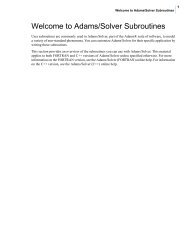You also want an ePaper? Increase the reach of your titles
YUMPU automatically turns print PDFs into web optimized ePapers that Google loves.
2.10.1 Head-Up Display<br />
Using <strong>Virtual</strong> <strong>Machine</strong> Models with CeRun and Gener<br />
Monitoring <strong>Virtual</strong> <strong>Machine</strong>’s Results<br />
The HUD superimposes<br />
status information on the<br />
simulation window. To<br />
change the content or<br />
position of the HUD,<br />
select the Simulation»Display<br />
(Ctrl Alt D<br />
shortcut) menu to bring up<br />
the Display dialog. Status<br />
information can be organized<br />
into different<br />
schemes, which can be<br />
labeled by name and saved<br />
in the Windows Registry<br />
(the Default scheme<br />
cannot be changed). You<br />
can cycle between different<br />
display schemes listed in the simulation window using the Simulation»Show»Next Display<br />
and »Previous Display (Ctrl D and Ctrl Shift D) menu selections. Uncheck the “Use default<br />
schemes in cycle” box to omit the Default scheme when cycling through different displays.<br />
The FPS Status Information item can be selected to measure the simulation window display rate,<br />
in the form “FPS a / b” (useful when testing Graphic card setting). The number “a” is the theoretical<br />
maximum number of screen updates per second that VM could do if all it had to do was<br />
redraw the display. The number “b” is the actual number of updates per second, and takes into<br />
account all other processing requirements.<br />
2.10.2 Animation Control<br />
Animation options are controlled from the VM<br />
Animation toolbar as well as from the Simulation»Options<br />
menu (Ctrl Alt O shortcut).<br />
The animation control options affect the simulation display speed. Selecting the “Continuous”<br />
mode will slow the simulation down to a specified factor of real time within the limitations of the<br />
CPU and graphics capabilities of your computer. When “Motion Step” is selected, the display is<br />
updated at the specified interval in motions, meaning that the simulation display is updated after<br />
every n motion steps. A third “Time Interval” method refreshes the display at the specified<br />
interval in seconds, which has the least impact in terms of CPU requirements.<br />
When in continuous animation mode, extremely slow motions may give the impression that the<br />
software is no longer operating. If unsure, activate the HUD motion display, which will show if<br />
axes are in fact moving. The Simulation Options dialog can be activated while the simulation is<br />
running (and even mid interpolation), allowing you to change the mode from continuous to<br />
another.<br />
<strong>ICAM</strong> Technologies Corporation – Proprietary 31















